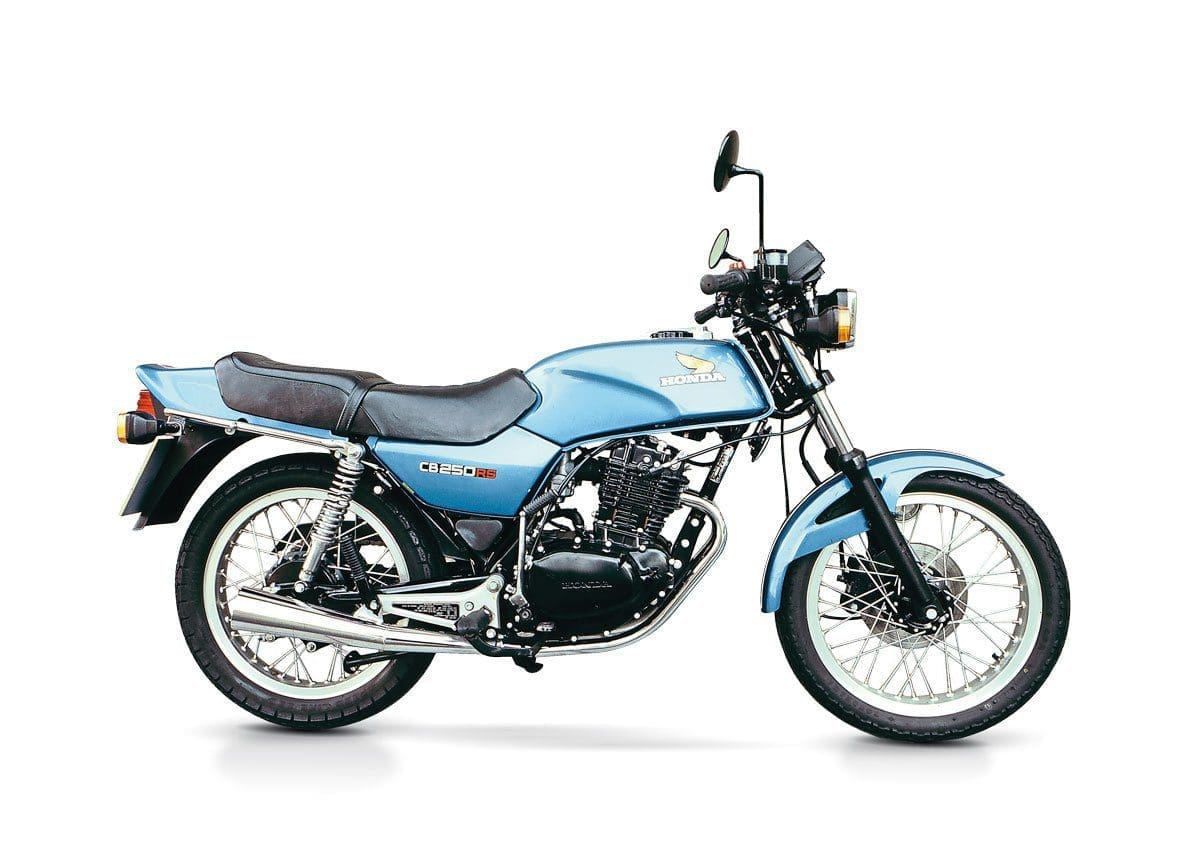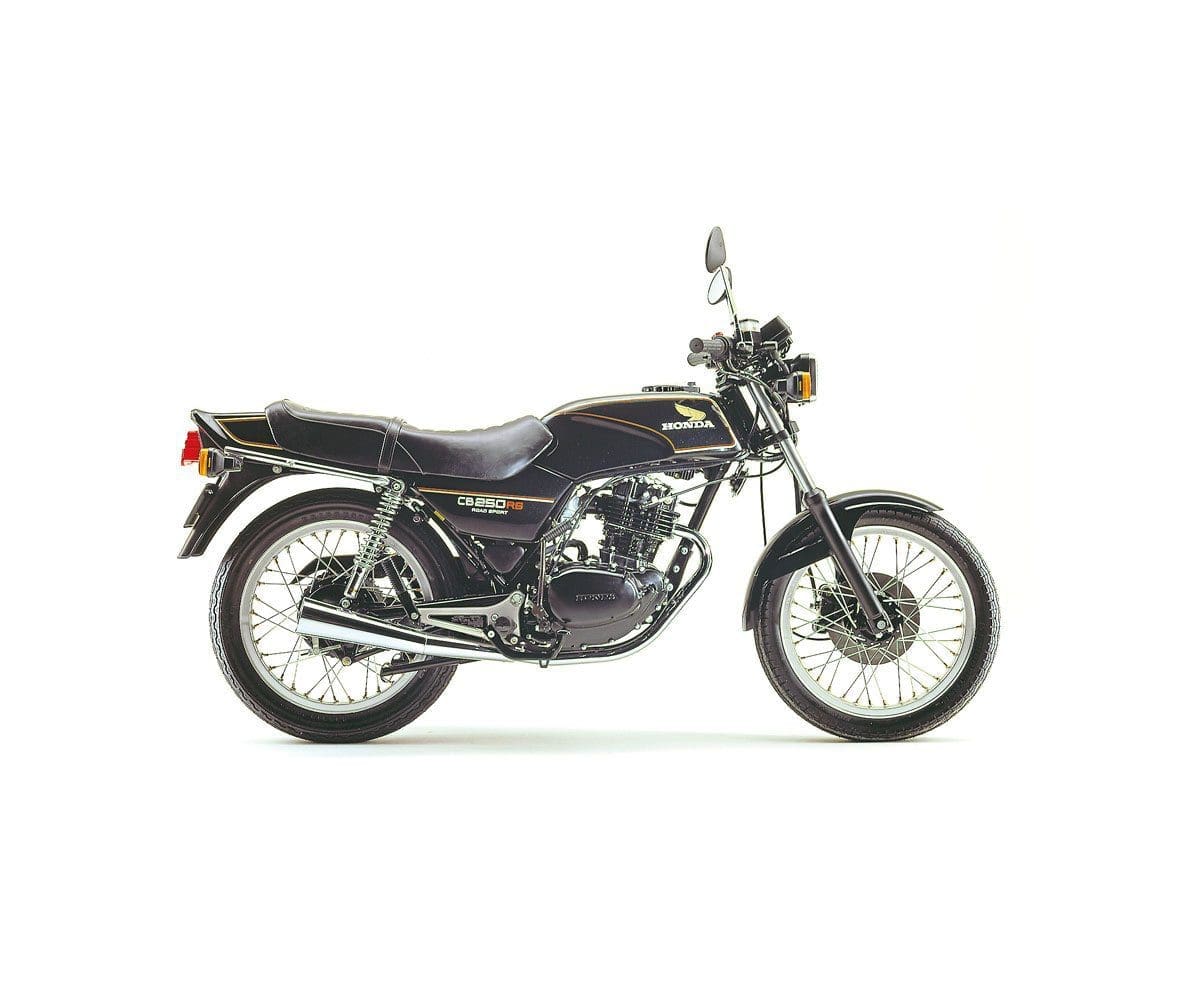Lightweight and agile, Honda’s CB250RS conflicted with its own Superdream for sales and was never as popular. Now, they can be a great back-lane bike with big H reliability.
In the late 1970s, Honda wAS cleaning up in the non-hooligan 250cc motorcycle stakes in the UK. It first replaced the ageing CJ250T with the rounded-off CB250T Dream, which in turn became the CB250N Superdream, beloved of the UK’s sensible learners.
At the same time, Honda was taking on the off-road opposition with its XL250S trail bike, which had a very neat single-cylinder, 248cc engine with a four-valve head. Until then, 250cc four-stroke trail bikes – especially British ones – vibrated a great deal, requiring sturdy cradle frames that made them rugged-enough off-road… and heavy. Honda took a radical step and fitted its new engine with balancer shafts: two counter rotating weights driven by chain to smooth things out. This meant that the frame could be much lighter as it didn’t need the beef to soak up the engine’s vibes.
Honda decided that dominating the sensible 250 market with the Superdream was not enough.
There were still people who thought the 250N a bit overweight and sluggish, so Honda took the XL engine and put it in a road bike. The CB250RS that resulted is the almost-forgotten gem of the early 1980s Honda line-up, and by building it Honda instantly created one of the sweetest mass-produced lightweights – a great bike for smaller riders or those who like different, and surely a classic of the future.

“You can really let yourself go on one, and the way it performs is like no other Japanese motorcycle of that size of the era. With a bike this slender and nimble, if you ground the pegs, you are about to fall off.”
The CB250RS
Made between 1980 and 1984, the 250RS had a short life in the showrooms, yet anyone who has owned or ridden one will wax lyrical about how lovely this little Honda is.
The electrical system was uprated to 12v from the trail bike’s six volts, and the frame pared was down even more than it had been on the XL. Like the XL it has no cradle, with the engine bolted to the front downtube at the front and close to the swing arm mounts at the back.
The lightness of the RS was such that it was 30 kilos (66lb) lighter than the CB250N Superdream. Officially it could crack 90mph, 4mph faster than its chunkier sibling. You could get an indicated 95mph on the clock and the engine thrived on revs. The light weight meant the handling was astonishingly good and the steering geometry was near perfect.
The handling is the important thing about the RS and it ran with 18-inch wheels front and back. You can really let yourself go on one, and the way it performs is like no other Japanese motorcycle of that size of the era. With a bike this slender and nimble, if you ground the pegs, you are about to fall off.
Its off-road upbringing showed as there was only a kick-start to get it going, with a probably unnecessary cable-operated decompressor that was activated automatically when you started to kick it over. The RS had curious angular styling, with small, square clocks and a rectangular headlight. The first models came in black or blue, with a red model following. Plentiful use of plastic, and good quality plastic at that, resulted in maintenance-free side panels, front and rear mudguards, and rear tail piece. A pair of parallel exhaust ports ran into twin pipes – after all, what’s the point of building a four-valve head if you’re not going to show it off? The skinny down pipes were matched with a slender pair of short megaphone-like silencers made with decent chrome. Honda sold a neat colour-matched handlebar fairing for the RS, too.
The updated RSD model was introduced by Honda in 1982 and came with an electric starter, even though the original RS was a second kick-starter every time and was sold alongside the RS. The RSD was also given more garish graphics which fitted the style of the rest of the Honda range but might have been a backward step, as the little single no longer stood out from the crowd. Unlike almost all the other 250s on the market, the RS continued to sell well after the introduction of the 125cc learner laws and was beloved by despatch riders. It was also popular with older, more experienced riders. More than a few have now been fitted with XL or FT500 engines and these make impressive undercover street scratchers, hill climbers, and sprinters.
Shock absorbers
Budget and better replacements are easy to find, but with such a light machine the originals may still work well. The originals were basic oil damped five adjustable items.
-
Exhaust
The exhaust systems tend to last well but if they are rotting, you can buy a pattern set for £280 from Classic Bike Shop. It’s not cheap and supplies won’t last forever, so looking after your exhausts is essential.Fuel and oil
The RS has a 2.9-gallon tank which, given its fuel sipping potential, gives you a range of well over 150 miles. The sump takes 1.7 gallons of oil.Frame
There’s not a lot of it, and this makes for a small motorcycle. The seat is a gnat’s over 30 inches off the ground which, when combined with the bike’s slender physique, makes it ideal for the shorter, lighter rider.Chain and sprockets
The originals wear quickly. Keep them well adjusted and lubricated, try and find a heavy duty set-up, and keep an eye for wear on the cush drive.Wheels
A pair of very smart alloy rims wrapped in old school 18-inch rubber: 3.00×18 at the front and 4.00×18 at the back. They look best with old patterns and Dunlop does a TT100 lookalike for the back and a K82 Gold Seal for the front. They also do a more modern Arrowmax in a matching pair. They’re not as period, but might be stickier.Engine
A compact 248cc single from the XL250S, producing 26bhp, the only real differences between the models are the conversion to 12 volts and the satin black paint job. Not completely bulletproof if neglected, it is however a willing performer if you watch the oil level.

Above: Some colourways were better than others, but a small tank, side panels and a rear unit won’t break the bank to paint
What to look out for
With a tiny sump that holds just over 1.7 litres of 10w-40, you must keep an eye on the oil consumption. The oil works very hard, so changing it every 1000 miles or so is essential.
The gearbox had problems in the early versions of the RS, with weak selector forks that could fracture; the design was quickly modified with extra webbing to beef them up.
The camshaft bearing surfaces, where the short camshaft runs straight into the alloy head, could suffer from under-lubrication and heavy wear. This is another reason for keeping an eye on the oil consumption and was once a regular issue with smaller Hondas. There was a healthy trade for engineering shops in machining out worn heads and putting in bearings for the camshaft. If the problem should arise today, a decent engineer should be able to do the work. Otherwise, the engine was pretty sound.
The original chain fitted by Honda wore very quickly, getting through a chain and sprocket set in about 7000 miles. The RS was popular enough for aftermarket retailers to produce a heavier-duty replacement set that was slightly wider and lasted a lot longer. The ‘deluxe’ RSD version had an O-ring chain. The downside of this was that the heavier chain and sprockets put extra strain on the cush drive. The cush drive rubbers are now very hard to find new, so a purchaser would be well advised to give the rear sprocket a careful examination and check for slack.

Above: The donor for the RS engine, Honda’s XL250S. Much sought-after nowadays and itself a great, fun bike
The balancer shafts are a crucial part of what makes the RS such a splendid little motorcycle and you need to listen out for unpleasant noises from the drive chain. You will soon realise if the balancing has gone out of phase as the vibration becomes intense very quickly.
There are easy-to-clean alloy rims on spoked wheels and a good disc at the front, Honda having finally worked out how to make a caliper that did the job of bringing a motorcycle to a halt. The caliper is a bit exposed, however, and will benefit from regular cleaning over the winter as the pad retaining pins can seize. Keep the choke cable well lubricated too, as it sits on the dash and is exposed to the weather.
The engine is put together with small bolts that can seize in the alloy casings. If you are going to work on one, spraying the fasteners with a penetrating oil like Soudal Degrip-All the day before will help avoid stropped threads.
Aside from those few issues the RS is very easy to live with. They are relatively simple to work on, require few special tools, and the fasteners are of common sizes. Many of the fasteners are small and tucked away so a 1/4-inch drive socket set will be essential. You can drop the engine out of the frame in no time at all, and all the important electrics are located under the side panels.
They don’t seem to get crashed a lot, and with folding footrests and everything apart from the exhausts tucked in, if it has been dropped it’s unlikely to have suffered major damage. You can easily pick a good one up for less than £2000, and make for great fun.

A short but happy life
I must admit to a soft spot for the RS, having owned one in the early 1980s. I had a job pumping gas at an old-fashioned local filling station for 60 hours a week, where I would be covered in diesel and smell of petrol. I cycled the five miles into work through glorious Devon countryside until I’d scraped a few quid together for a motorcycle.
I visited a local bike shop and looked at the stock which mostly contained a collection of three and four-year-old 550cc fours and 1000cc behemoths. There, lurking unnoticed in the corner, like an unwanted spaniel in a dogs’ home, was a Honda CB250RS. It just seemed right and fitted me perfectly. There was brief haggle, they gave me twice what I had expected for my decaying CB500T, sorted out the finance, and bunged me a free crash helmet into the bargain.
Riding the Honda back home, I loved it instantly. The little beast flew along – it had a ridiculous top speed on the clock, the slickest gear change I had ever come across, and it handled like it ran on rails, to use a popular term of the time, and it did about 75mpg.
It was comfortable and felt beautifully put together, far better that the previous generation of Hondas, and it was more than capable of keeping up with bikes twice its size.
I moved from the countryside to the fleshpots of Exeter and found I could cover the 11-mile journey to work in 13 minutes. I loved that little flyer and went everywhere on her… chased girls, hurtled through the night on gallant missions and insane adventures, and found it was perfect for the South West’s greatest biking roads.
After two years of ownership, it ended up embedded firmly in the side of Mercedes in a ‘sorry mate I didn’t see you’ moment. A sad end for a lovely little motorcycle.
Words by Oli Hulme


